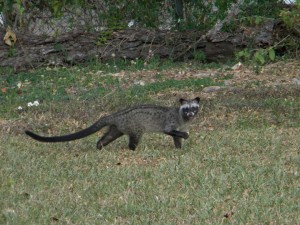The common palm civet (Paradoxurus hermaphroditus) has a characteristic black mask over their eyes and they are long creatures with the length of their bodies proportionate to the length of their tails. It is a mammal that is native to Singapore, but people don’t usually see them because they tend to be active at night to forage for food such as fruits, insects and small animals to eat. Sometimes, people might mistake civets to be cats or raccoons. They are neither, and belong to the family Viverridae instead. The viverrids are scientifically classified under the order Carnivora because of its dentition (they possess carnassial teeth). Many carnivoran members have a wide diversity of diet and the common palm civet has a predominant fruit diet, hence, an omnivore.
Currently in Singapore, there are four extant civet species (small-toothed palm civet, malay civet, large indian civet and the common palm civet). The common palm civets, being the only species that can be seen in Singapore’s urban areas, hence, they are one of the last wild, native urban carnivores left in Singapore. Not many people know they exist, but they are almost always amongst us, nestling in vegetation or in cosy roof spaces. With their fruit-eating habits, they could also play an important role as seed dispersers, helping in the regeneration of forests through passing out seeds in their faeces.
Unfortunately, the civet is vulnerable to many threats such as both house and wild dogs, fast cars, animal traps of all kinds, and even poachers. Sometimes, when civets wander into the homes of people, they may be met with hostility.
We hope to raise awareness of the common palm civet and its existence in Singapore, so that the public will know more about this animal and what to do should they come across one. We also hope to mitigate any existing conflict between humans and civets, and impart an appreciation for these beautiful creatures instead.
(Photo credits, from left: Xu Weiting, Francis Yap, David Wells.)





Saw a civet in the garden today- must have been heading for bed.
I need do no more than leave it alone, correct?
Hi Robert, yes, the civet should be just going along its daily business.
If you are able, please help to put in a civet sighting record here – mammal.sivasothi.com.
Thank you!